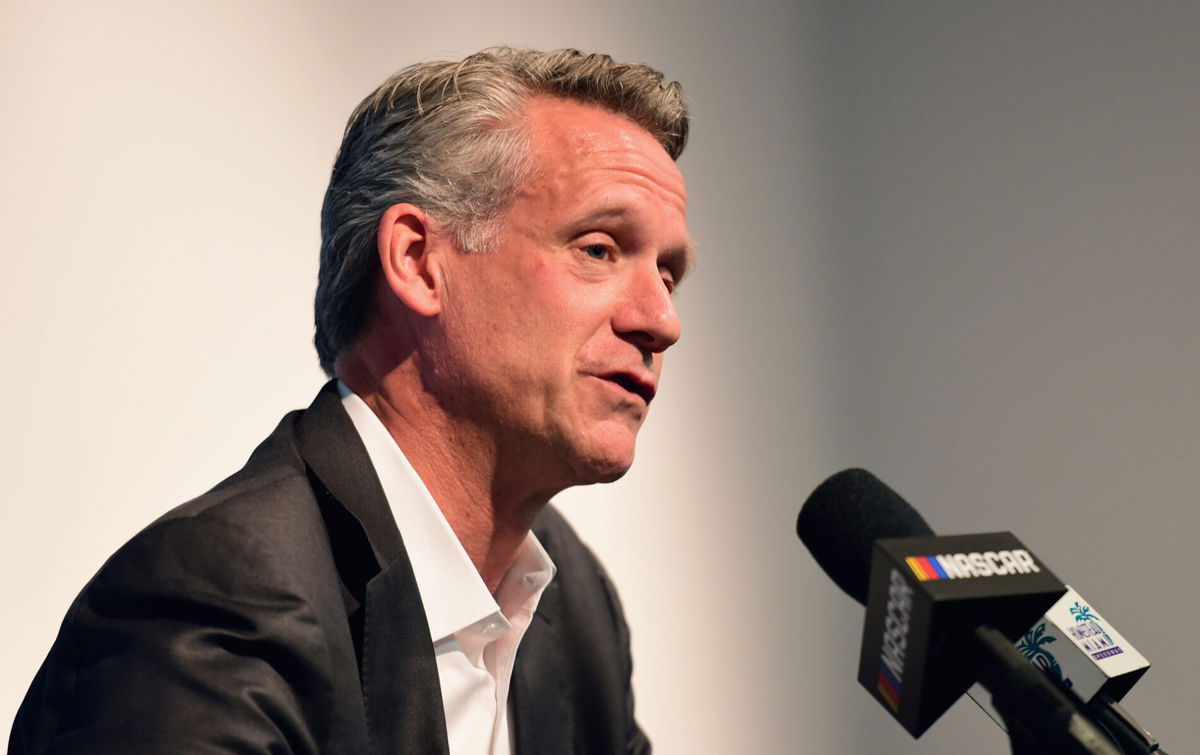
Getty
HOMESTEAD, FL – NOVEMBER 18: NASCAR President Steve Phelps speaks to the media prior to the Monster Energy NASCAR Cup Series Ford EcoBoost 400 at Homestead-Miami Speedway on November 18, 2018 in Homestead, Florida. (Photo by Jared C. Tilton/Getty Images)

Getty
HOMESTEAD, FL – NOVEMBER 18: NASCAR President Steve Phelps speaks to the media prior to the Monster Energy NASCAR Cup Series Ford EcoBoost 400 at Homestead-Miami Speedway on November 18, 2018 in Homestead, Florida. (Photo by Jared C. Tilton/Getty Images)
It’s not just roaring V8 engines, ultra-efficient crews, and skillful drivers that keep the lights on for NASCAR. After all, the media-promotion side of things enables the sport to not just thrive but grow its audience and allow the drivers and teams to reap the reward for their efforts. Unfortunately, the sport isn’t growing; apart from a slight spike, the viewership numbers have been on a steady decline for years.
Watch What’s Trending Now!
However, the recent news of a potential deal for streaming rights struck between NASCAR and OTT giants Amazon Prime, Disney, and Discovery could change that. In a world where the end goal for any organization is to generate revenue, the ability to keep dedicated fans engaged while attracting newer ones is of utmost importance.
ADVERTISEMENT
NASCAR learns from WWE’s mistakes with the new Amazon and Disney deal
NASCAR hopes its $7.7 billion broadcasting rights deal will help slingshot the series and get it at par with the likes of Formula 1. But things could go south for the sport if they repeat mistakes made by other sporting leagues.
Appearing in a special issue of Dirty Mo Media’s live feature, prominent journalist Adam Stern joined the hosts in a lengthy discussion about the new media deal and how NASCAR needs to go about their business to make this a successful venture.
Top Stories
‘I Was Never Gonna Date Another Wrestler’: Married for Two Years, Seth Rollins Reveals How He Almost Never Ended Up With Becky Lynch

Wrestling Legends Put Massive Pressure on Gable Steveson’s Minnesota Teammates After Inspiring Big 10 Result

REPORT: Real Reason Why WWE Monday Night RAW Underwent Temporary Set Change

“He’s America Wrapped Up in a Flag”: John Cena’s Bona Fide Total Divas Clips With Ex-Fiancé Nikki Bella Fascinated a Female Hollywood Celebrity

“Every Single Week I Just Ask a Different Person”: John Cena Once Casually Buried His Emotions for Ex-Fiancé Nikki Bella 4 Months Before Their Painful Break Up

ADVERTISEMENT
ADVERTISEMENT
Stern shed light on the workings of other sports leagues where teams are usually co-owners of the league itself, splitting the revenue amongst themselves. Unlike other sports leagues, NASCAR is not owned by the teams that participate in the sport, hence, the revenue-sharing model is bound to be different.
He added, “There’s kind of this thought that, ‘Hey, sports is this place where money grows on trees and the values are just going to escalate no matter what until the end of time.’ Not necessarily true. The media companies right now, just over the last year have started to come under significant pressure in a lot of ways. Investors are looking for them to be more profitable.”
Taking real-world examples, the reporter alluded to the Pac-12 collapse in college sports, which he attributed to the fact that media companies were not increasing their expenditure into these leagues as they had done previously. He also shared the example of WWE, which is facing a major market crisis amidst ongoing media rights negotiations, “You also look at WWE’s recent media rights deal. They didn’t gain quite the increase that investors were hoping for, which caused the WWE stock to tank a little bit.” Stern believes that WWE’s failure could have been a thorn in NASCAR’s side during their own media rights negotiations.
ADVERTISEMENT
Stern commended the sport’s organizers on their ability to overcome the hurdles faced by other organizations and get the deal underway. He said, “And so NASCAR had to negotiate its deal amidst all of this, and it’s not easy, that’s part of why it took longer than they were hoping for, but at the end of the day they were able to get this 1.1 Billion annual average value which will hopefully help set them up to strike a deal with their team, and not lead to a major disruption or some issues we’ve seen in other sports.”
WATCH THIS STORY: The unforeseen gamble: Larry McReynolds’ Daytona 500 risk
With the sport’s future hanging in the balance, the new media rights deal could pay dividends for NASCAR if all goes to plan. Whilst the pressure is on for the sport to recreate its glory days, the new deal in itself is a big step in the right direction.
ADVERTISEMENT
How the current $7.7 Billion proposition beats the previous $8.2 Billion deal
Elaborating on the financials behind the new deal on the table with Amazon, Disney , and Discovery, Stern pointed out the significant stride NASCAR has made in its annual revenue generation. He shared, “Going off of the numbers that we are hearing, it’s less total money than in terms of what they got last time, last time it was 8.2 Billion dollars, but that was over ten years. So they got 820 million average annual value.”
ADVERTISEMENT
In contrast to the previous deal, which paid out 8.2 billion over ten years, the newer deal is supposed to provide NASCAR with an annual average value of $1.1 Billion per year! Which would make it worth over 300 million per year more than its predecessor, despite being a lower value over the seven years. Stern added, “This time, it’s 7.7 billion over 7 years. So almost the same amount they got over ten years, they will get over seven.”
ADVERTISEMENT
It’s safe to say that NASCAR is on the right track towards securing a bright future for the sport we all have come to love. However, the failures of the WWE and Pac-12 are stark reminders of an outcome that the organizers must desperately avoid.
READ MORE: Amidst NASCAR’s Ongoing Sponsor Crisis, Insider Speculates Worsening Situations Post 2024 Calendar
ADVERTISEMENT
ADVERTISEMENT
ADVERTISEMENT

